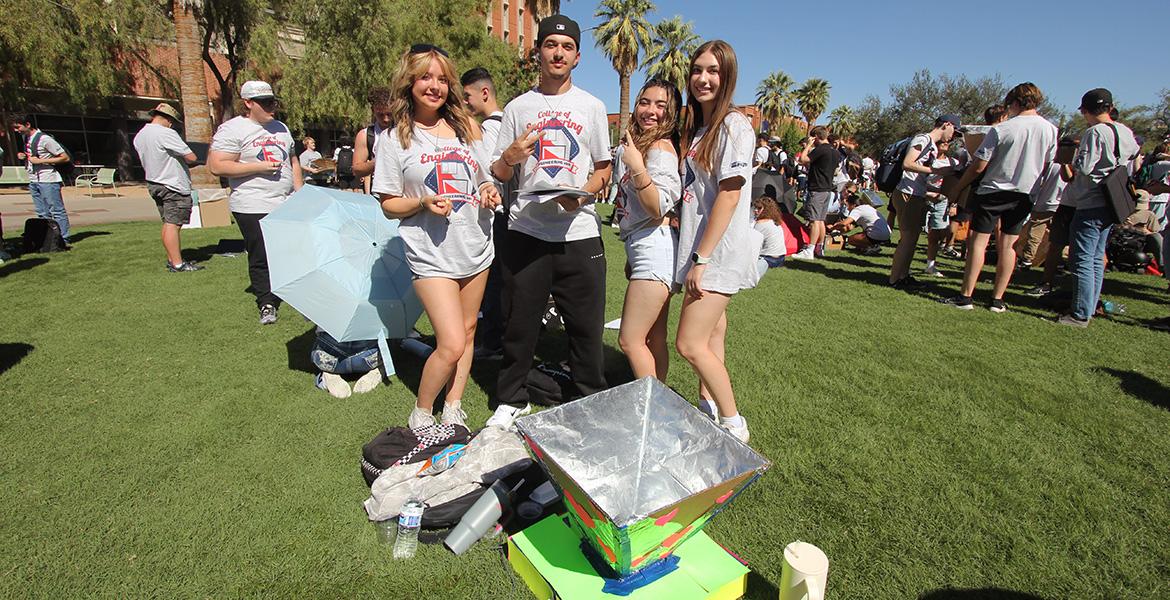Solar Oven Throw Down 2024: ‘No more silos’
Without a cloud in sight, the sun heated the University of Arizona Mall to a high of 94 degrees Fahrenheit. A group of 711 U of A students filled the lawn and took advantage of the beautiful day for a friendly competition to determine who could build the hottest solar oven out of recyclable materials.
At the Solar Oven Throw Down on Oct. 15, first-year students in the Engineering 102 course applied foundational engineering and mathematical principles to amplify the Arizona heat with cardboard and aluminum foil designs.
Team Solar Nation, of materials science and engineering professor Sammy Tin’s class, reached the highest average temperature of the day by an individual team at 487 degrees Fahrenheit, one degree higher than last year’s winner.
Anwar Gatto, an electrical and computer engineering student from another Tin team, truly enjoyed the competition.
“It was fun working with a group and being able to design with support from professors,” he said.
Baking biscuits with a dream team
Hands-on Engineering 102 activities immediately immerse students into the four-year Craig M. Berge Engineering Design Program. SOTD is the first experiential learning activity where students build models and perfect them as a team.
“There are no more silos of engineers,” said Byron Hempel, chemical and environmental engineering assistant professor of practice and faculty coordinator for the event.
“One of the best things that we do in our College of Engineering is make sure everyone can work on a team.”
The event celebrated that cooperation with a special award. The “All in the Same Boat” Teamwork Award, from longtime event sponsor W.L. Gore and Associates, honored the team who overcame challenges together.
Team Enjiners, from aerospace and mechanical engineering professor Cholik Chan’s class, won this year’s distinction.
Powerful predictions
Reaching the highest individual temperature and collaborative teamwork were just two of the SOTD awards. The most coveted honor is achieving highest average performance index (PI) at the class level.
“Although highest temp is a good metric to compare, the PI based on their model prediction is what we care about most,” Hempel said.
Adjunct lecturer Ken George’s class came out on top with an average PI of 20, meaning his students built theoretical models that most accurately predicted the temperature they reached on the mall.
“A PI above 10 is good,” Hempel added. “Ken George's average PI is amazing.”
Salpointe Catholic High School teacher Cecelia Gossler leads Engineering 102 High School, in which students at participating schools can take the U of A’s introductory course and earn college credit. At SOTD this year, 26 of her students joined the competition.
The skills required for the event will be put to good use, said Gossler, a U of A industrial engineering alum with bachelor’s and master’s degrees. Her students will also take part in EPICS – Engineering Projects and Community Service – by picking a community group and solving a problem related to that organization’s mission.
“They can use everything that they've learned here and at the Solar Track Meet to actually help somebody,” Gossler said.
Engineering 102 students will revisit the friendly rivalry at the Solar Track Meet in November. To prepare for the meet, students first become certified in 3D printing. Then they team up and use that skill to build autonomous solar trackers that follow the sun’s movements to collect solar energy.




